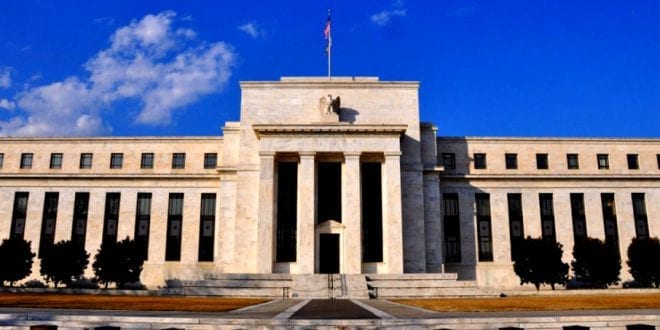The failure of Silicon Valley Bank (16th largest bank in US) last Friday resulted from depositors withdrawing their funds in response to a drop in value of the bank’s bond portfolios caused by the Federal Reserve’s ill-considered hikes in interest rates.
The mindless policy implemented by the Federal Reserve cures inflation by producing bank runs, failed banks, and unemployment.
The Federal Reserve and neoliberal economists are still stuck in the worn out thinking of 20th century Keynesianism, writes Dr. Paul Craig Roberts, chairman of The Institute for Political Economy, former associate editor of the Wall Street Journal and a regular contributor to The Herland Report.
Federal regulators seized New York’s Signature Bank which was overwhelmed by deposit withdrawals.
The banks’ failures, with troubles reported afflicting Republic Bank (14th largest in the US) and reports that many Wells Fargo depositors experienced zero balances due to a glitch of the digital revolution has left those fortunate enough to have bank balances an entire weekend to work themselves into a panic about the safety of their own bank deposits. The question is whether panicked depositors rush to withdraw their money Monday, March 13, 2023.

Mindless policy by the Federal Reserve: Hoping to avoid this, the Federal Reserve announced on Sunday that it would provide banks with cash to meet withdrawals. The Federal Reserve announced that all depositors in Silicon Valley and Signature banks, including those with deposits above the insured amount, would be protected.
With the Federal Reserve backstopping the banking system as it is supposed to do (and failed to do during the Great Depression), bank problems and the panic they produce will hopefully be contained. In the last 14 months, bank reserves have declined by $1.3 trillion.
This means that banks are short the cash to meet withdrawals and would have to sell financial assets to meet withdrawals. These sales would depress the prices of the financial assets, and impair the banks’ balance sheets.
RELATED ARTICLES:
- Matt Taibbi: Digital McCarthyism Twitter Files, Horrifying Repression at Google, Twitter, Facebook
- The Federal Reserve Cartel – Eight Families own the USA #BIS, IMF, World Bank
- Is the Federal Reserve Merely Incompetent or Is There a Dark Agenda?
- The Federal Reserve oligarch owners: Out-sourcing the Monetary System since 1913
Mindless policy by the Federal Reserve: Of course, as during the previous financial crisis, government and financial executives will make reassuring statements, such as the one made by Treasury Secretary Yellen last Friday when she reassured the public that the American banking system is resilient and well capitalized.
But is it? The five banks labeled “too big to fail” have $188 trillion in derivatives. The brutal fact is that 5 US banks have risk exposure that is twice the size of the GDP of the entire world. It is incomprehensible that 5 US banks have sufficient capital to back derivative bets that are twice the size of world GDP.
We owe the financial crisis earlier this century, and we will owe the next financial crisis, to the mindless repeal of the Glass-Steagall Act. This legislation was passed in 1933 to deal with the crisis at that time.
The law did so by separating commercial from investment banking. This prevented commercial banks from using deposits for speculative purposes. The law prevented financial crisis for 66 years until it was repealed in 1999 during the Clinton administration.
Alan Greenspan, the Federal Reserve Chairman at that time, argued that markets were self-regulating and did not need Washington’s help. This suited the big banks fine. You can learn about the consequences from Michael Lewis’ books.
In short, a couple of Wall Street firms failed along with banks and insurance companies. The five largest banks were protected by Quantitative Easing, thus leading to explosive growth in the Federal Reserve’s balance sheet, inflated values of financial instruments, and the current possibility of another financial crisis.
Congress and economists would not admit their mistake in repealing the highly successful Glass-Steagall Act, but public resentment of big bank bailouts caused Congress to pretend to fix the situation. Congress “fixed” the problem it had created by legislating the ability of your bank to seize your deposits to prevent its failure.
The law was deceptively called the Dodd-Frank Wall Street Reform and Consumer Protection Act of 2010. It claimed to “protect the American taxpayer by ending bailouts,” but did so by bailing out banks with the depositors’ money instead of federal tax revenues. It was said to be a “bail in” instead of a “bail out.” Ellen Brown explains it here.
There was no valid reason for overturning Glass-Steagall. It happened because public policy has ceased to be in the public interest, instead serving private agendas. The commercial banks wanted to participate in the speculative ventures like investment banks and enjoy the same high earnings.
Instead of using their own money, they wanted access to the money of their depositors. Free market ideologues serving their free market ideology provided the justification. But as we relearned a few short years afterward, markets are not self-regulating.
Thus the consequent distortion of the economy by a decade of Quantitative Easing, the consequences of which are not over.
What can be done? Repeal Dodd-Frank Monday morning. It is the most foolish legislation since Prohibition. It protects the banks and the general taxpayer at the expense of depositors, thus encouraging runs on banks. It took a completely mindless Congress to pass such destructive legislation.
Mindless policy by the Federal Reserve: Also drive home the message that all deposits are protected. It is important to realize that among deposits too large to be insured are monies for payrolls of large businesses.
Then set to work with legislation requiring banks to restructure their investment bank operations and separate them in a different entity from deposit based banking with deposits insulated from investment banking.
The effect would be to re-establish Glass-Steagall.
It is possible that darker forces are at work. The five big banks, knowing that they are protected by the Fed, regard bank failures as opportunities to buy up assets for pennies on the dollar. The three New York banks, who control the New York Fed, the operating arm of the Federal Reserve, might even have their greedy eyes on Bank of America and Wells Fargo.
The existing trillions of dollars of derivative bets were made when interest rates were lower. When these contracts are reset, it will be at higher interest rates, so the value of the bets would be adversely affected. Ellen Brown explains what might be a Derivative Tsunami.
One still reads in the financial media that banks finance businesses and new investment, but they don’t. Banks finance purchases of existing assets and speculative derivative bets that produce profits for investment banks but nothing real for the economy. Indeed, derivatives have become extreme risks with no productive purpose.










